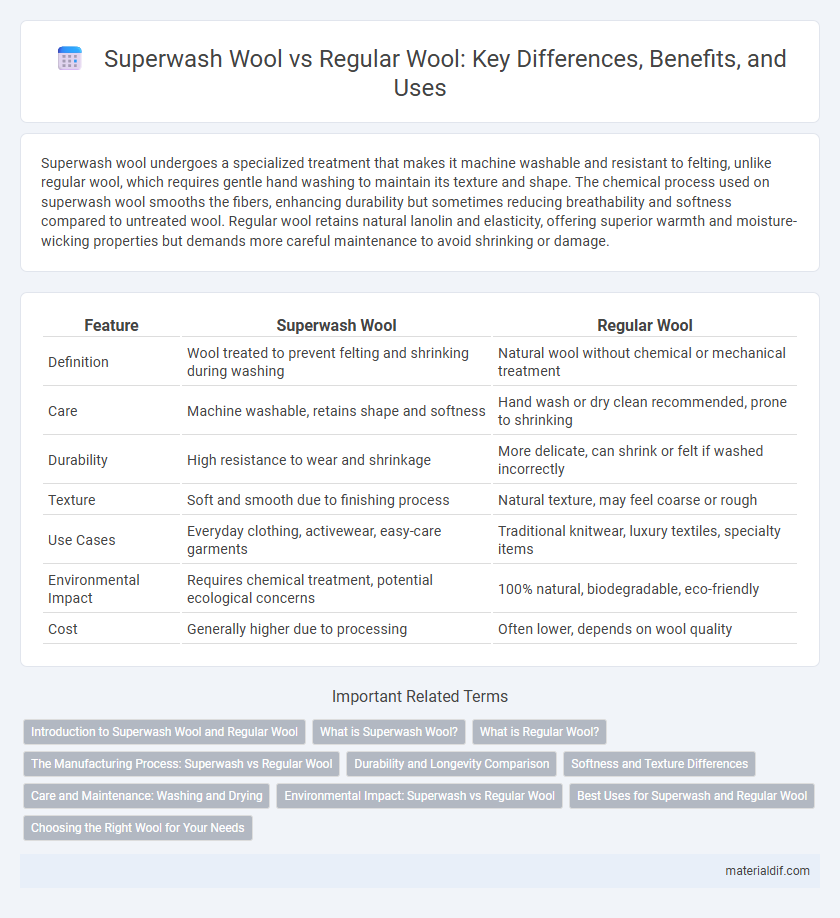Superwash wool undergoes a specialized treatment that makes it machine washable and resistant to felting, unlike regular wool, which requires gentle hand washing to maintain its texture and shape. The chemical process used on superwash wool smooths the fibers, enhancing durability but sometimes reducing breathability and softness compared to untreated wool. Regular wool retains natural lanolin and elasticity, offering superior warmth and moisture-wicking properties but demands more careful maintenance to avoid shrinking or damage.
Table of Comparison
| Feature | Superwash Wool | Regular Wool |
|---|---|---|
| Definition | Wool treated to prevent felting and shrinking during washing | Natural wool without chemical or mechanical treatment |
| Care | Machine washable, retains shape and softness | Hand wash or dry clean recommended, prone to shrinking |
| Durability | High resistance to wear and shrinkage | More delicate, can shrink or felt if washed incorrectly |
| Texture | Soft and smooth due to finishing process | Natural texture, may feel coarse or rough |
| Use Cases | Everyday clothing, activewear, easy-care garments | Traditional knitwear, luxury textiles, specialty items |
| Environmental Impact | Requires chemical treatment, potential ecological concerns | 100% natural, biodegradable, eco-friendly |
| Cost | Generally higher due to processing | Often lower, depends on wool quality |
Introduction to Superwash Wool and Regular Wool
Superwash wool undergoes a special treatment that removes the wool scales, preventing felting and allowing machine washing without shrinking or matting. Regular wool retains its natural scales, making it warm and breathable but prone to shrinkage and felting when washed improperly. This key difference influences care requirements and fabric durability in garments and textiles.
What is Superwash Wool?
Superwash wool is treated with a special chemical process that removes the scales on the wool fibers, preventing felting and shrinkage during washing. This treatment allows garments made from superwash wool to be machine-washed without losing their softness or shape, unlike regular wool which requires delicate hand washing or dry cleaning. Superwash wool maintains the natural warmth and breathability of wool while offering greater convenience and durability for everyday use.
What is Regular Wool?
Regular wool is natural sheep fiber that retains its original texture and requires careful hand washing or gentle machine cycles to prevent shrinking and felting. It contains scales on the fiber surface, which cause fibers to interlock and create dense, warm fabrics but increase the risk of damage during cleaning. Unlike superwash wool, regular wool lacks a chemical or mechanical treatment that makes it machine washable and more resistant to shrinkage.
The Manufacturing Process: Superwash vs Regular Wool
Superwash wool undergoes a specialized manufacturing process where its scales are chemically treated or coated with a polymer to prevent felting and shrinkage, allowing it to be machine-washable. Regular wool retains its natural scales, which interlock during washing, leading to shrinkage and felting if not handled carefully. This key difference in treatment makes superwash wool more durable for easy care without compromising the softness and warmth intrinsic to wool fibers.
Durability and Longevity Comparison
Superwash wool undergoes a chemical treatment that removes the scales on the fiber surface, making it machine-washable and less prone to felting, thereby enhancing its durability compared to regular wool. Regular wool retains its natural scales, which contribute to its traditional softness but also make it more susceptible to shrinking and pilling with frequent washing. In terms of longevity, superwash wool typically withstands repeated laundering better, while regular wool may offer superior warmth and breathability when cared for gently.
Softness and Texture Differences
Superwash wool undergoes a special treatment that removes the scales on the fiber surface, resulting in a smoother texture and reduced itchiness compared to regular wool. This process enhances softness, making superwash wool ideal for garments worn directly against the skin. Regular wool retains its natural scales, providing more texture and warmth but often feeling coarser and less soft to sensitive skin.
Care and Maintenance: Washing and Drying
Superwash wool is treated with a chemical process that allows it to be machine washed without felting or shrinking, making it ideal for easy care and low-maintenance garments. Regular wool requires gentle hand washing or dry cleaning to preserve its natural fibers and avoid damage, as it is prone to shrinking and felting when exposed to agitation or high temperatures. When drying, superwash wool can be laid flat or dried on low heat, while regular wool should always be reshaped and dried flat away from direct heat to maintain its shape and texture.
Environmental Impact: Superwash vs Regular Wool
Superwash wool undergoes chemical treatments, such as chlorine-based processes, to make it machine-washable, which results in higher water pollution and energy consumption compared to regular wool. Regular wool relies on natural lanolin and requires gentler washing methods, minimizing environmental pollutants and reducing chemical waste. Choosing regular wool supports more sustainable practices by avoiding the toxic runoff associated with superwash treatments.
Best Uses for Superwash and Regular Wool
Superwash wool offers enhanced durability and easy care, making it ideal for everyday garments like socks, sweaters, and baby clothes that require frequent washing without shrinking. Regular wool, known for its natural breathability and superior insulation, excels in outdoor gear, heavy winter wear, and high-performance textiles where warmth and resilience are critical. Both types serve unique purposes: superwash wool prioritizes convenience and low maintenance, while regular wool maintains traditional qualities favored in rugged and temperature-sensitive applications.
Choosing the Right Wool for Your Needs
Superwash wool undergoes a special treatment that allows for machine washing without felting, making it ideal for easy-care garments and everyday wear. Regular wool retains its natural texture and breathability, offering superior insulation and durability, preferred for traditional knitting and outdoor use. Selecting between superwash and regular wool depends on balancing convenience with performance needs.
Superwash Wool vs Regular Wool Infographic

 materialdif.com
materialdif.com